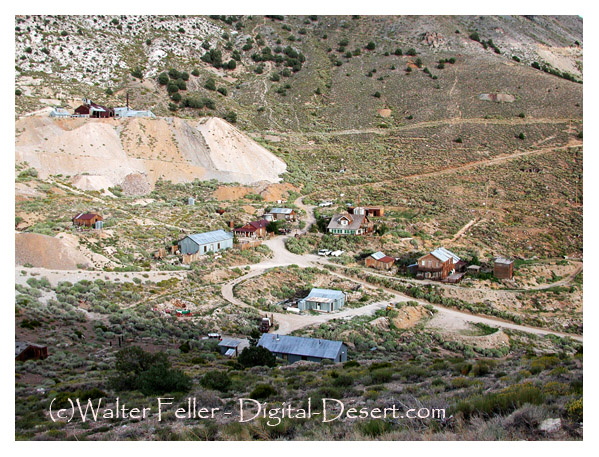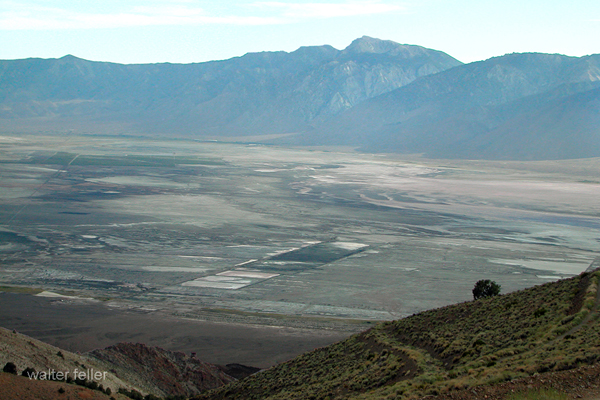Cerro Gordo
The "fat hill" produced silver, lead and zinc for a century. At its peak over 1,000 people lived here working in mines as the San Felipe and Union. At the time the smelters were the best there were. Silver was roasted and formed into bullion, sent down the Yellow Grade road by mule team, then shipped across Owen's Lake by steamboat. From the lakeside port of Cartago the bullion was loaded onto Remi Nadeau's freighters and hauled into Los Angeles.Click the photo to go to the gallery

The Story of Cerro Gordo
Cerro Gordo is an historic mining town in Inyo County, California, located approximately seven miles east of Keeler and thirty miles to the south of Independence on the western slope of the Inyo Mountains. Cerro Gordo, the "Fat Hill" proved a most exciting tale of discovery, boom and decline.Early Discovery and Development
The story of Cerro Gordo begins in 1865 when a group of wandering prospectors descending from the Coso area stumbled upon a very rich silver deposit at the toe of Buena Vista Peak in the Inyo Mountains. When one of these prospectors, Pablo Flores, discovered remarkable silver float, it opened the way for the organization of the Ygnacio, San Francisco, and San Felipe mines. These early miners, who were predominantly Mexicans, operated with very small resources. They smelted the silver ore in crude "vaso" furnaces made of adobe and stone. Lacking capital, they were able to work out significant quantities of silver. Thus, for instance, Jose Ochoa managed to extract an incredible one and a half tons of ore every 12 hours from the San Lucas mine in the year 1866.Making Cerro Gordo a Household Name
As early as 1868, it appeared that the richness of the silver deposits at Cerro Gordo had become well-known throughout California. It had captured the attention of San Francisco capitalists as well, including Mortimer Belshaw, who seems to have been quite taken with the Cerro Gordo region's prospectus. Belshaw himself and a few associates formed the Union Mining Company and acquired the interests of nearly all the Mexican claim holders in the area. Joaquin Almada, for instance, swapped his right to the property for a one-fifth interest in the new smelter that Belshaw would build. Before long, Belshaw bought out Almada's interest and became one of the two "kings of the mountain." The other mogul was Victor Beaudry, another San Francisco merchant who had established a store at Cerro Gordo in 1866. Through attachments for overdue accounts, Beaudry also acquired extensive mining property from Mexican prospectors.Belshaw and Beaudry, under their considerable capital, built two large smelters by the year 1870. In 1871, the mining camp of Cerro Gordo has been established and the town produced $4,000 value of silver per day. The town flourished and the American Hotel became the most beautiful structure and social center of the town. Many saloons and two houses of prostitution also splurged in this good time of the town.
The Boom Years
At its height, Cerro Gordo was a boomtown. In excess of 1,000 people resided in and worked in the town; mines, including the San Felipe and Union, were extraordinarily rich. Ore would be taken down the treacherous, winding Yellow Grade road by pack teams before being shipped across Owens Lake by steamboat. It was from the lakeside port of Cartago where the bullion was loaded aboard Remi Nadeau's freighters and hauled into Los Angeles. This fully integrated transport system was what really allowed Cerro Gordo to mine its potential.Cerro Gordo silver bullion was key to the growth of California. Metal extracted at Cerro Gordo in particular helped in the growth of Los Angeles. Throughout the 1870s, more than 100 twenty-mule team wagons brought freight to Los Angeles from Cerro Gordo, and in return, Los Angeles received 200 tons of silver and lead every month.
Difficulties and Decline
Cerro Gordo, although successful, faced several difficulties. In 1875, the combination of no ore, a short drought and lawsuits claiming mine ownership put the furnaces out of business. In 1876, the Union Consolidated Mining Company of Cerro Gordo raised new capital and attempted to resume production, but it was short-lived. By late 1876 and early 1877, the Union Mine was almost worked out and a disastrous fire added to the problems. The final blow was caused by falling lead and silver prices, bringing an end to this period of activity at Cerro Gordo. From 1880 to 1911, mineral production of Cerro Gordo faltered. However, the finding of zinc ores between the years 1911 through 1915 reopened a new boom. Cerro Gordo was now the leading producer of zinc in California. Great quantities of silver, lead, and zinc continued to be produced until the mines closed in the 1950s.Legacy of Cerro Gordo
Today, Cerro Gordo is a ghost town with remains of the bustling past. The remains of Victor Beaudry's smelter are still found, housed in a stone reverberatory furnace near the caved-in portal of the Omega Tunnel, and Newtown Mine's shafthouse is there. Other features of these early twentieth-century zinc mines now part of the landscape are the metal sheds and other ruins.The ore cars that once conveyed silver, lead, and zinc by rail to the tram house are visible, and remains of the tramway are still. The Mexican "vaso" furnaces lying half a mile to the south of Cerro Gordo speak to the extremely early contribution by Mexican miners to this region.
For its part, Cerro Gordo produced over $15,000,000 in ore value from the time of its discovery back in 1865, a figure that topped that produced in any other silveror lead-producing area in California. Its story of discovery, boom, and eventual decline encapsulates in a nutshell the volatile and most often dramatic stories of mining towns in the American West.
In this context, the story of Cerro Gordo is the romantic example of those hard miners and their ingenuity. From its beginning with small-scale operations by Mexican prospectors to the peak as a major producer of silver, lead, and zinc, Cerro Gordo played a large role in the mining history of California. But today, even with the struggles of operation and eventual decline, the legacy of Cerro Gordo lives on, giving a window into yesterday and the indomitable spirit that fashioned the American West.

The Story of Inyo - Cerro Gordo
American Hotel, Cerro Gordo
Cerro Gordo (Desert Fever)
Rise and Fall of Cerro Gordo
Cerro Gordo
Cerro Gordo is an abandoned mining town in central Inyo County. It consists of a number of wooden buildings, the most imposing of which is the two-story ...
Remi Nadeau
During the silver-mining excitement in the Cerro Gordo region of Inyo County his ... Remi Nadeau's Cerro Gordo Freighting Company hauled the charcoal to the ...
-
Mojave Desert Mining History - Includes additional northern areas
The Rise & Fall of Cerro Gordo Originally a small-scale operation worked by Mexicans between 1862 and 1866, the mine was included . ...
Timeline of History of the Mojave Desert
1873 Remi Nadeau operates 80 freight teams hauling silver bullion from the mines at Cerro Gordo to Los Angeles 1883 Railroad completed ...
Inyo County Mining History
... not in finding the Lost Gunsight Mine, but gold, which developed into Coso.4 . By permission. Russ Harthill · Coso · White Mountain City · Cerro Gordo ...
Tecopa Mines
At approximately the same time Pablo Flores discovered Cerro Gordo, silver-lead ores were discovered at Tecopa. Little is known of the early history of this ...
Beveridge
Production on the Comstock fell to $20,000,000 (half it's 1876 production) while Darwin and Cerro Gordo were also declining rapidly. ...
Cerro Gordo Graveyard
As a busy silver mining town Cerro Gordo had its fair share of deaths. At one time several hundred graves were marked along the hill overlooking the Owens ...
Cerro Gordo Route Guide
The rich silver mines of Cerro Gordo, high in the Inyo Mountains, transformed the pueblo of Los Angeles into a busy center of commerce. ...
Mojave Desert Ghost Towns
Landing and loading point for bullion from Cerro Gordo mines. ... Port and bullion production town for Cerro Gordo mines. ...
Lone Pine California
Cartago In the 1870's bullion bars from Cerro Gordo mines were hauled across Owens ... THE RICH SILVER MINES OF CERRO GORDO, HIGH IN THE INYO MOUNTAINS, ...
Owens Valley
Ghost Towns - Owens Lake port for bullion from Cerro Gordo. ... Ghost Town - Refining and shipping operations for Cerro Gordo. ...
Route Guides
The rich silver mines of Cerro Gordo, high in the Inyo Mountains, transformed the pueblo of Los Angeles into a busyy center of commerce. ...
Owens Valley: Mojave Desert Ecological Subsections
Owens Valley as seen from Cerro Gordo, Inyo Mountains Owens Valley Wilderness Areas Coso Range · Inyo Mountains · Malpais Mesa Geomorphic Province ...
Mojave Desert Wilderness Areas
Cerro Gordo 59. Fossil Falls 62. Jawbone/Butterbedt 63. Horse Canyon 64. Last Chance Canyon 65. Desert Tortoise Area 66. Western Rand Mountains ...
Cartago - Owens Valley
In the 1870's bullion bars from Cerro Gordo mines were hauled across Owens Lake on the steamer "Bessie Brady" to Cartago boat landing. ...
Swansea
Two furnaces smelting silver ore coming out of Cerro Gordo were built and the town boomed to over 2000 people. During World War one, Swansea was the ...
Keeler Ghost Town, north Mojave Desert, Owens Valley
Keeler was built to compete with Swansea as a smelting operation and port for shipping silver and lead from the Cerro Gordo mines. ...
Wildrose Charcoal Kilns - Death Valley National Park
Remi Nadeau's Cerro Gordo Freighting Company hauled the charcoal to the smelters by pack train and wagon. Each of the 10 kilns stands about 25 feet tall and ...
Cottonwood Kilns - Mojave Desert
... the "Mollie Stevens" or "Bessie Brady" steamers, then hauled by wagon up the "Yellow Grade" to the Cerro Gordo mines for use in thier smelter furnaces. ...
Horseshoe Meadow Route Guide
At the canyon's head are the ruins of Stevens' Sawmill, where Colonel Sherman Stevens supplied wood for the Cerro Gordo mining operation (Route 1). ...
Inyo Mountains Wilderness
ACCESS: Access the southern boundary via the San Lucas Canyon or Cerro Gordo roads. The west and northern reaches via the Lone Pine-Owenyo and Mazourka ...